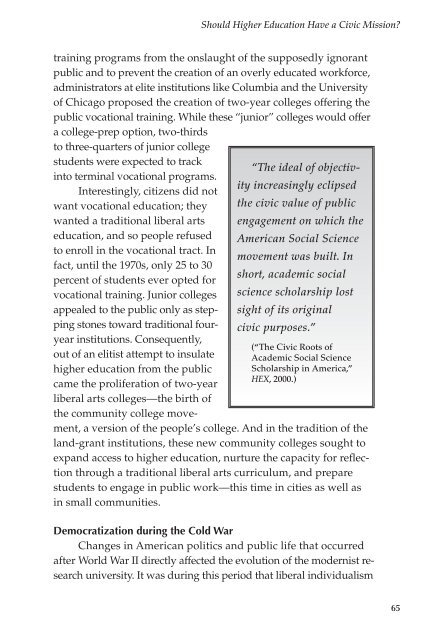Agent of Democracy - Society for College and University Planning
Agent of Democracy - Society for College and University Planning
Agent of Democracy - Society for College and University Planning
Create successful ePaper yourself
Turn your PDF publications into a flip-book with our unique Google optimized e-Paper software.
Should Higher Education Have a Civic Mission?<br />
training programs from the onslaught <strong>of</strong> the supposedly ignorant<br />
public <strong>and</strong> to prevent the creation <strong>of</strong> an overly educated work<strong>for</strong>ce,<br />
administrators at elite institutions like Columbia <strong>and</strong> the <strong>University</strong><br />
<strong>of</strong> Chicago proposed the creation <strong>of</strong> two-year colleges <strong>of</strong>fering the<br />
public vocational training. While these “junior” colleges would <strong>of</strong>fer<br />
a college-prep option, two-thirds<br />
to three-quarters <strong>of</strong> junior college<br />
“The ideal <strong>of</strong> objectivity<br />
increasingly eclipsed<br />
the civic value <strong>of</strong> public<br />
engagement on which the<br />
American Social Science<br />
movement was built. In<br />
short, academic social<br />
science scholarship lost<br />
sight <strong>of</strong> its original<br />
civic purposes.”<br />
(“The Civic Roots <strong>of</strong><br />
Academic Social Science<br />
Scholarship in America,”<br />
HEX, 2000.)<br />
students were expected to track<br />
into terminal vocational programs.<br />
Interestingly, citizens did not<br />
want vocational education; they<br />
wanted a traditional liberal arts<br />
education, <strong>and</strong> so people refused<br />
to enroll in the vocational tract. In<br />
fact, until the 1970s, only 25 to 30<br />
percent <strong>of</strong> students ever opted <strong>for</strong><br />
vocational training. Junior colleges<br />
appealed to the public only as stepping<br />
stones toward traditional fouryear<br />
institutions. Consequently,<br />
out <strong>of</strong> an elitist attempt to insulate<br />
higher education from the public<br />
came the proliferation <strong>of</strong> two-year<br />
liberal arts colleges—the birth <strong>of</strong><br />
the community college movement,<br />
a version <strong>of</strong> the people’s college. And in the tradition <strong>of</strong> the<br />
l<strong>and</strong>-grant institutions, these new community colleges sought to<br />
exp<strong>and</strong> access to higher education, nurture the capacity <strong>for</strong> reflection<br />
through a traditional liberal arts curriculum, <strong>and</strong> prepare<br />
students to engage in public work—this time in cities as well as<br />
in small communities.<br />
Democratization during the Cold War<br />
Changes in American politics <strong>and</strong> public life that occurred<br />
after World War II directly affected the evolution <strong>of</strong> the modernist research<br />
university. It was during this period that liberal individualism<br />
65

















